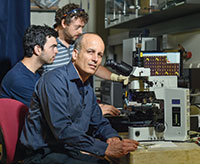
Researchers at the Technion-Israel Institute of Technology have developed a method for growing carbon nanotubes that could lead to the day when molecular electronics replace the ubiquitous silicon chip as the building block of electronics. The findings were recently published in the journal Nature Communications.
Carbon nanotubes (CNTs) have long fascinated scientists because of their unprecedented electrical, optical, thermal and mechanical properties, and their chemical sensitivity. But significant challenges remain before they can be implemented on a wide scale, including the need to produce them in specific locations on a smooth substrate, in conditions that will lead to the formation of a circuit around them.
Led by Prof. Yuval Yaish of the Viterbi Faculty of Electrical Engineering and the Zisapel Nanoelectronics Centre at the Technion, the researchers have developed a technology that addresses these challenges. Their breakthrough also makes it possible to study the dynamic properties of CNTs, including acceleration, resonance (vibration) and the transition from softness to hardness. The method could serve as an applicable platform for the integration of nanoelectronics with silicon technologies, and possibly even the replacement of these technologies in molecular electronics.

“The CNT is an amazing and very strong building block with remarkable electrical, mechanical and optical properties,” said Prof. Yaish. “Some are conductors, and some are semiconductors, which is why they are considered a future replacement for silicon. But current methods for the production of CNTs are slow, costly and imprecise. As such, they generally cannot be implemented in industry.”
Due to the nanometre size of the CNTs (100 000 times smaller in diameter than the thickness of a human hair) it is extremely difficult to find or locate them at specific locations. Prof. Yaish, and graduate students Gilad Zeevi and Michael Shlafman, developed a simple, rapid, non-invasive and scalable technique that enables optical imaging of CNTs.
Instead of depending upon the CNT chemical properties to bind marker molecules, the researchers relied on the fact that the CNT is both a chemical and physical defect on the otherwise flat and uniform surface. It can serve as a seed for the nucleation and growth of small but optically visible nanocrystals, which can be seen and studied using a conventional optical microscope (CNTs, because of their small size, are too small to be seen in this way). Since the CNT surface is not used to bind the molecules, they can be removed completely after imaging, leaving the surface intact, and preserving the CNT’s electrical and mechanical properties.
“Our approach is the opposite of the norm,” Yaish continued. “We grow the CNTs directly, and with the aid of the organic crystals that coat them, we can see them under a microscope very quickly. Then image identification software finds and produces the device (transistor). This is the strategy. The goal is to integrate CNTs in an integrated circuit of miniaturised electronic components (mainly transistors) on a single chip (VLSI). These could one day serve as a replacement for silicon electronics.”
For more information visit www.ats.org
© Technews Publishing (Pty) Ltd | All Rights Reserved